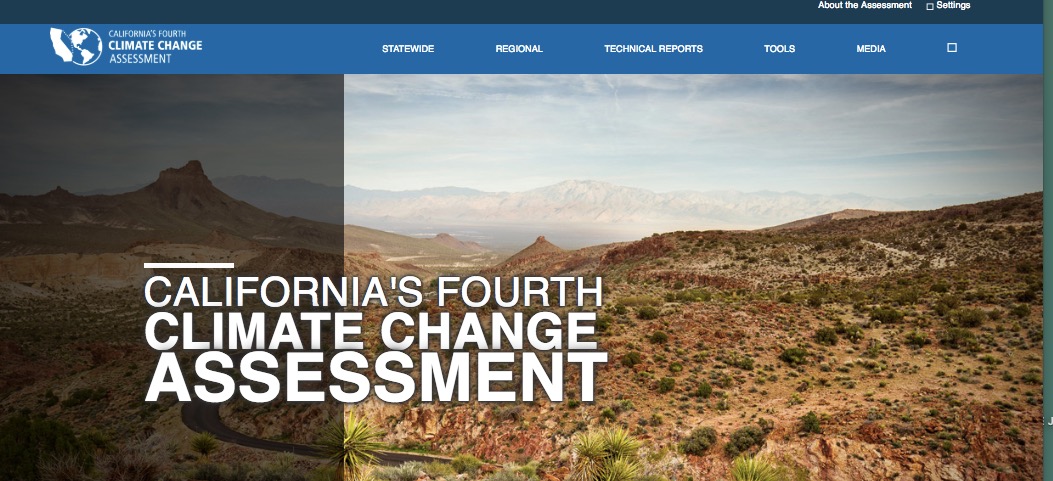New Report/Data: California’s Fourth Climate Change Assessment
From the Global Climate Action Summit:
Warning that two-‐thirds of Southern California’s beaches could completely disappear and the average area burned by wildfires could nearly double by 2100, the State of California today released California’s Fourth Climate Change Assessment, which details new science on the devastating impacts of climate change and provides planning tools to support the state’s response.
[Clip]
California has completed three prior Climate Change Assessments. Since the release of California’s Third Climate Change Assessment in 2012, the state has experienced several of the most extreme natural events in its recorded history, including a severe five-‐year drought, an unprecedented tree mortality crisis, damaging floods driven by atmospheric rivers, and increasingly large and destructive wildfires.
The Fourth Assessment suggests these events will worsen in the future. Among the key findings:
- Wildfire: Climate change will make forests more susceptible to extreme wildfires. By the year 2100, if greenhouse gas emissions continue to rise, one study found that the average area burned by wildfires would increase 77 percent and the frequency of extreme wildfires burning more than 25,000 acres would increase by nearly 50 percent. In the areas that have the highest fire risk, the cost of wildfire insurance is estimated to rise by 18 percent by 2055. Additionally, the percentage of property insured in California would decrease.
- Sea-‐Level Rise: Under mid to high sea-‐level rise scenarios, up to 67 percent of Southern California beaches may completely erode by 2100 without large-‐scale human interventions. Statewide damages could reach nearly $17.9 billion from inundation of residential and commercial buildings if sea-‐level rise reaches 20 inches, which is within range of mid-‐century projections. A 100-‐year coastal flood, on top of this level of sea-‐level rise, would almost double the cost of damages. Updated modeling can help local planners analyze vulnerabilities in their area.
- Energy: Higher temperatures will increase annual electricity demand for homes, primarily for use of air conditioning units. High demand is projected in inland regions and Southern California. More moderate increases are projected in cooler coastal areas. Increases in peak hourly demand during the hot months of the year could be more pronounced. This is a critical finding for California’s electric system, because generating capacity must match peak electricity demand.
- Extreme Heat Events and Impacts on Public Health: Heat-‐related illnesses and deaths are projected to worsen drastically throughout the state. By mid-‐century, the Central Valley is projected to experience heat waves that average two weeks longer than those today, and the hot spells could occur four to 10 times more often in the Northern Sierra region. A new California Heat Assessment Tool (CHAT) could support public health departments as they work to reduce heat-‐related deaths and illnesses.
The latest reports also detail the unique and disproportionate climate threats to vulnerable communities and tribal communities, with a focus on working collaboratively with these communities on research and solutions for resilience.
In addition, a report set for release in early September will highlight how California can better integrate climate impacts in design processes for critical infrastructure. The report by a working group established by AB 2800 (Quirk) of 2016 reflects the expertise of multiple scientific and engineering disciplines to help design and construct infrastructure to withstand higher temperatures, more frequent and intense storms, drought, wildfires and sea-‐level rise.
Resources
Direct to Fourth Climate Change Assessment: Findings, Summary Report, Regional Reports, Technical Report, and More
See Also: California Climate Assessment Provides Tools to Support Responses to Climate Impacts
Filed under: Data Files, News, Reports
About Gary Price
Gary Price (gprice@gmail.com) is a librarian, writer, consultant, and frequent conference speaker based in the Washington D.C. metro area. He earned his MLIS degree from Wayne State University in Detroit. Price has won several awards including the SLA Innovations in Technology Award and Alumnus of the Year from the Wayne St. University Library and Information Science Program. From 2006-2009 he was Director of Online Information Services at Ask.com.



